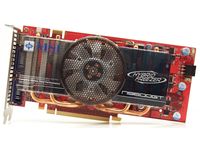Four GeForce 9600 GT Cards Compared
MSI GeForce 9600 GT Hybrid Freezer (N9600GT Hybrid Freezer)
MSI employs a somewhat unusual concept with its Hybrid Freezer. The card is both passively and actively cooled. The fan doesn’t throttle down under mild loads, but is completely deactivated in 2D applications. The card remains silent until the graphics processor (GPU) has heated up the card enough to trigger the fan.
The card is cool at the start, and with the GPU temperature at 40 °C, the fan is completely turned off for complete silence. Without a load in 2D applications, it takes about 15 minutes to heat up the graphics chip to 79 °C, which causes the 70 mm fan to switch on. At 40.7 dB(A) you can hear a faint whirring. It takes about 4 minutes to cool the GPU down to 39 °C, at which point the fan turns off and the card is completely silent again.
These numbers were taken from an open test platform. With better airflow through the cooling solution, or when under different GPU loads (like when you’re watching videos), the times for heating and cooling will naturally vary. Because the bottom of the cooler is open and the fan sits in the middle, a maximum of only 50% of hot air is blown out of the housing; the rest is recirculated inside the PC housing.
In 3D applications, a lot more heat is created. The fan turns on a lot sooner, but stays at a constant noise level of 40.7 dB(A) which is still pretty quiet. Note that when the fan stops, you cannot rely on the information GPU-Z displays because this tool gives different values for fan speed even if it’s not turning.
The GeForce 9600 GT (G94) supports Shader Model 4.0 and DirectX 10. MSI equipped our test sample with 1 GB of DDR3 graphics memory, which doesn’t really give you any advantages at resolutions of up to 1920x1200 pixels without anti-aliasing (AA). When you have anti-aliasing on, the performance of the graphics chip falls below playable levels, although you can measure an increase in performance from 5 to 7.5 fps in Crysis due to the large memory. If you want to run two GeForce 9600 GT cards in SLI mode, you should go with the 1 GB version, as the larger memory ceiling has more of an effect on performance due to the higher GPU power.
The standard clock speeds for the 9600 GT are 650 MHz for the GPU, memory at 900 MHz, and shader clocks at 1,625 MHz. MSI sets the GPU speed at 700 MHz, the shader speed at 1,680 MHz, and the memory speed remains at 900 MHz. The clock speeds are set in the BIOS and therefore can be used with any driver version. In our test, this lightly overclocked card performs 4% better than the standard card. If you want to overclock the memory and shader even more, you can gain another 4% with a 3 GHz CPU. The memory chips are not cooled by the cooler, so if you do overclock, you should keep an eye on chip temperatures.

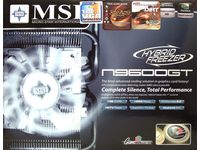

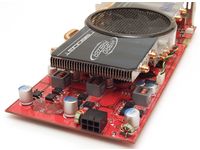

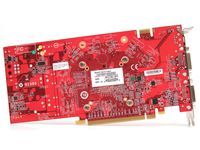

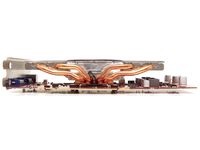
Get Tom's Hardware's best news and in-depth reviews, straight to your inbox.
Current page: MSI GeForce 9600 GT Hybrid Freezer (N9600GT Hybrid Freezer)
Prev Page Asus Software Next Page MSI Software-
JAYDEEJOHN So it beats the GTX eh? And you can find brand new nVidia drivers, but no ATI ones? And wheres the 4670? Got halfway thru, decided to skip the restReply -
jaragon13 What about the HD 4850? It costs less than the "last 8800 GTS 512's"Reply
Asus sells them for what? 170 dollars,free shipping on Newegg?
Maybe I even saw one @ 160... -
Sus-penders Why would anyone get an 8800GTS for $179 when you can buy a better performing HD 4850, for LESS money??? ATI still exists, you know...Reply -
Ryun No offense, as the article and tests run were good (I especially like the overall FPS charts), but this information would have been more pertinent, like, 6 months ago.Reply -
Niva Uh, I don't get what the people about are upset for. It's a good article, I enjoyed reading and seeing where these cards fit into the scheme of things. I know ATI has made a comeback with their recent cards but until their drivers are completely open and stable I'll stick with nVidia myself so I especially enjoyed this article. Thanks Toms!Reply -
L1qu1d Waste of 3 mins, it makes very little sense, the 9600 GTs in sli are around the 280 GTX in performance, yet it manages to get destroyed by the 4870.Reply
This article would've meant something around the time the cards came out...now I'd much rather like to see the 4850 cards compared or 260s or w.e else that is this gen. -
MooseMuffin NivaUh, I don't get what the people about are upset for. It's a good article, I enjoyed reading and seeing where these cards fit into the scheme of things. I know ATI has made a comeback with their recent cards but until their drivers are completely open and stable I'll stick with nVidia myself so I especially enjoyed this article. Thanks Toms!Reply
Exactly what is open about nvidia's drivers? -
warezme warms my heart to see the old 8800GTX included in this test list.Reply
It's amazing this ancient cards at default speed still sit in the middle of the pack and quickly rise to the top when you turn up AA and texture quality up, beating most every other card cept for 260GTX and SLI and CF rigs.
It also explains why a pair of old 8800GTX's in SLI OC'ed to at least Ultra speeds on a fast rig are still very hard to out perform by any single card (period) -
There is a reason to get the 9600GT over the 8800GT, power consumption. Look at the numbers, the 9600GT has 1/2 the number of shaders (hence a smaller die). I know the shader clock runs a little faster but a good quality stock PSU with 300W (real, like antec, corsair, etc) should be fine for running it.Reply
